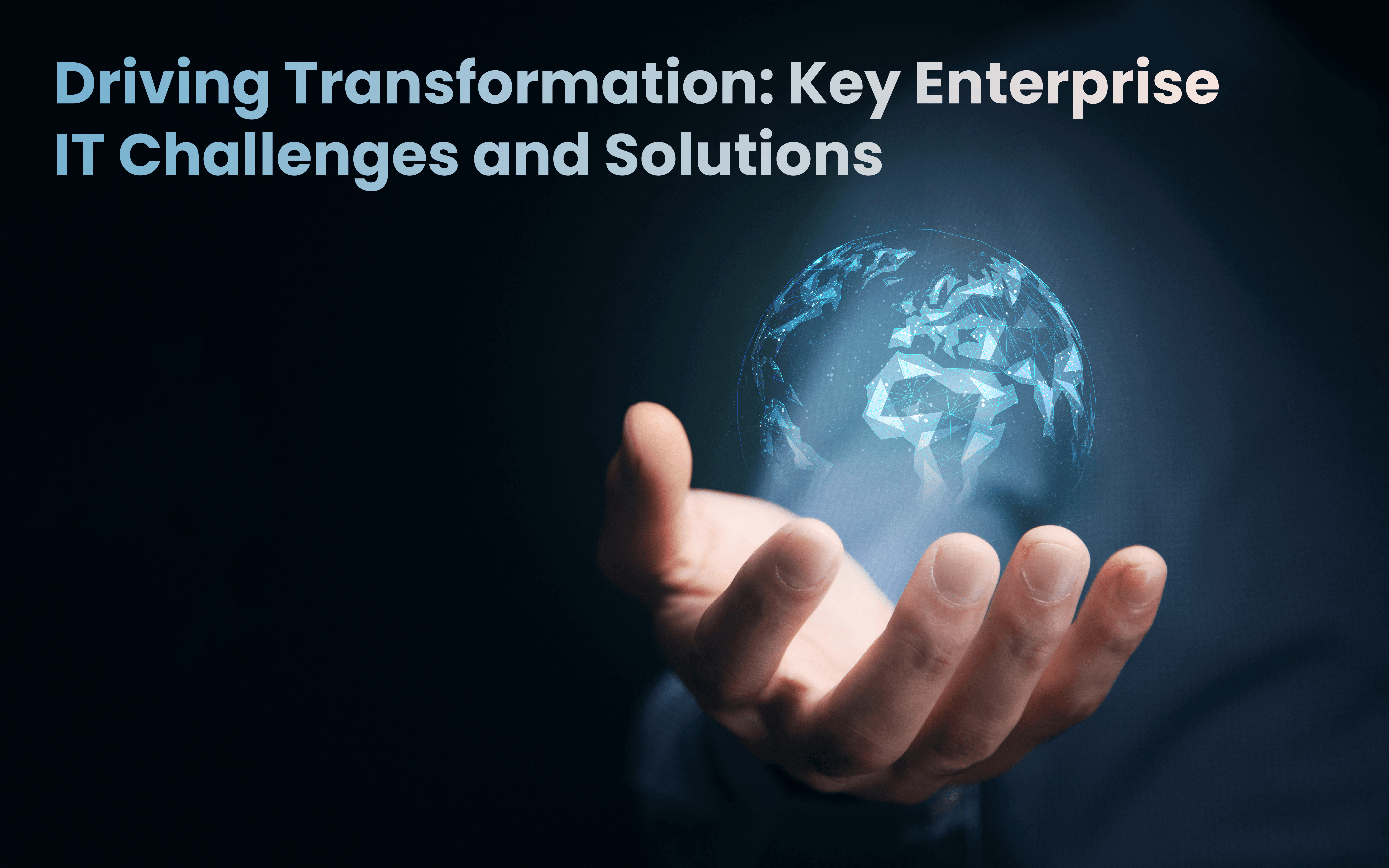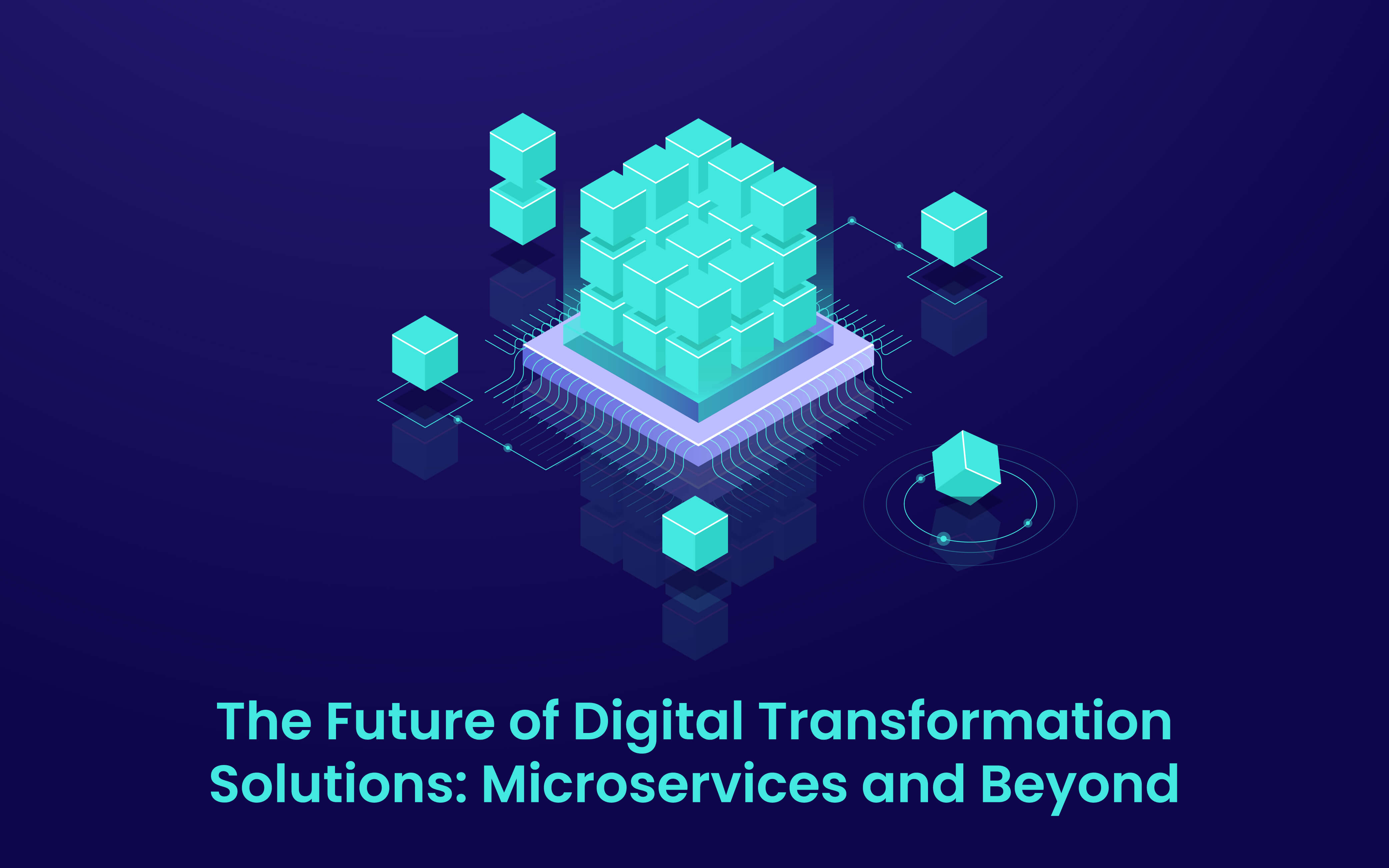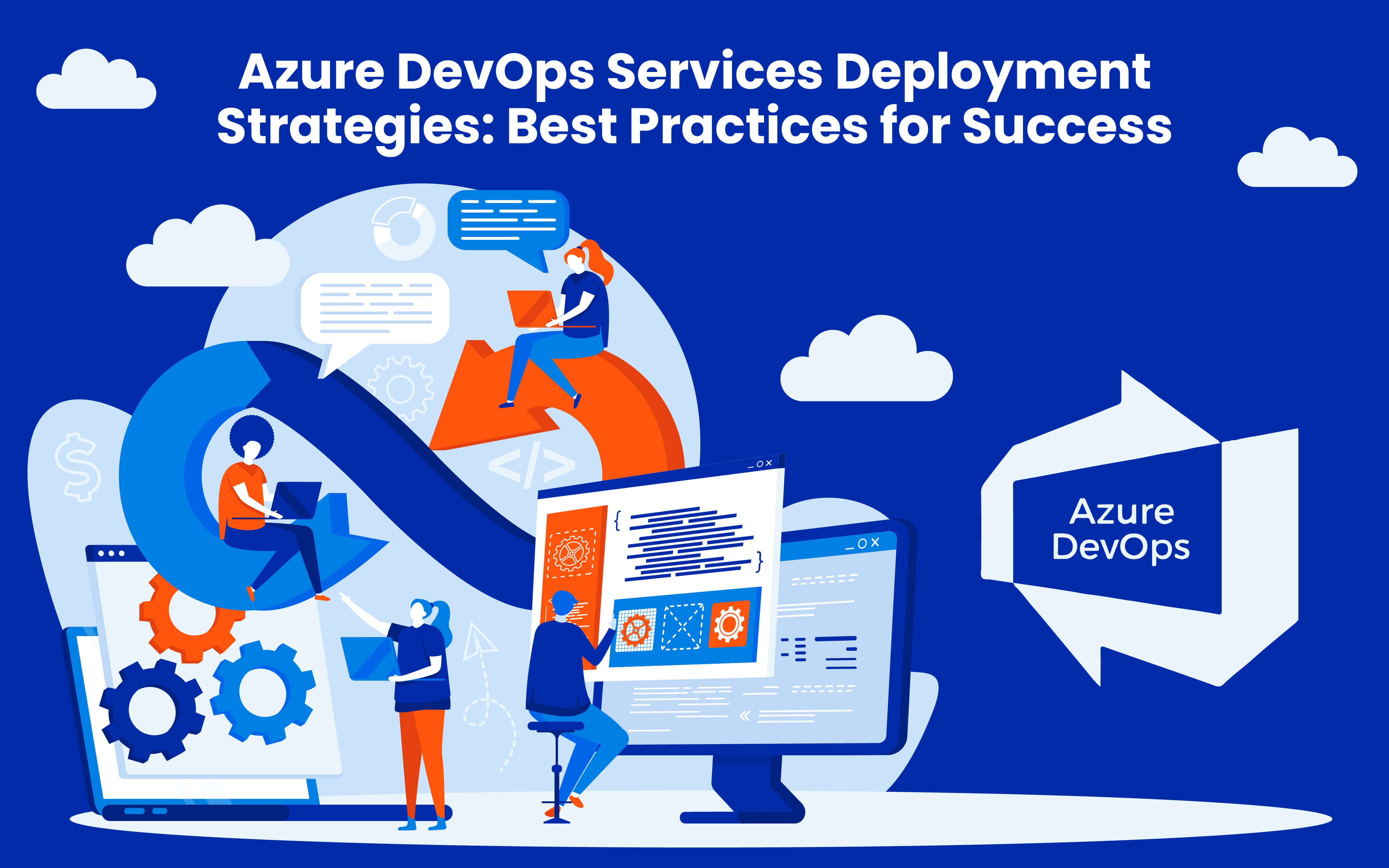Blogs
To know about all things Digitisation and Innovation read our blogs here.
Digital Transformation
Driving Transformation: Key Enterprise IT Challenges and Solutions
SID Global Solutions
3 July 2023

Introduction
In today’s rapidly evolving digital landscape, enterprises face numerous IT challenges as they strive to drive transformation. This comprehensive guide explores the key challenges encountered during enterprise IT transformation initiatives and provides detailed solutions to overcome them. From legacy systems to security concerns, we delve into each section to offer practical insights and strategies for success.
Also Read: Next-gen Applications: Embracing AI APIs for Intelligent Solutions
I. Legacy Systems Modernization
The Impact of Legacy Systems on Transformation
Legacy systems are one of the primary obstacles to successful IT transformation initiatives. Outdated technologies and infrastructure pose significant challenges that need to be addressed:
Outdated Technologies and Infrastructure: Legacy systems often rely on outdated hardware and software that can limit performance, hinder system upgrades, and result in compatibility issues. To address this challenge, organizations can consider the following solutions:
- Upgrade Hardware and Software: Evaluate the existing infrastructure and identify components that require upgrading or replacing. Invest in modern hardware and software solutions that offer improved performance, scalability, and compatibility with emerging technologies.
- Virtualization and Containerization: Consider virtualization technologies or containerization platforms like Docker to abstract applications from the underlying hardware and facilitate portability, scalability, and ease of deployment.
Incompatibility with Modern Systems
Integrating legacy systems with modern technologies and platforms can be a complex task due to compatibility issues and disparate architectures. To overcome this challenge, organizations can adopt the following strategies:
- API Integration: Implement Application Programming Interfaces (APIs) to facilitate seamless communication and data exchange between legacy systems and modern applications. APIs act as a bridge, enabling legacy systems to interact with new systems, platforms, or cloud services.
- Middleware Solutions: Explore middleware tools and platforms that provide integration capabilities, such as Enterprise Service Bus (ESB) or Integration Platform as a Service (iPaaS). These solutions help standardize data formats, handle data transformations, and enable smooth integration between disparate systems.
Scalability and Integration Challenges
Legacy systems may struggle to scale up or down based on changing business needs and lack the flexibility to integrate with modern systems. Consider the following approaches to address these challenges:
- Modular System Design: Decompose monolithic legacy systems into modular components, allowing for independent scaling and easier integration with new technologies. Adopt microservices architecture or service-oriented architecture (SOA) principles to achieve modularity and flexibility.
- Cloud Migration: Consider migrating legacy systems to the cloud to leverage its scalability and flexibility. Choose between Infrastructure as a Service (IaaS), Platform as a Service (PaaS), or Software as a Service (SaaS) models based on the organization’s specific requirements.
- Data Migration and Integration: Plan and execute a robust data migration strategy while ensuring data integrity, accuracy, and consistency. Leverage data integration tools and techniques to synchronize data between legacy systems and modern applications in real-time or batch processes.
Strategies for Legacy Systems Modernization
- Assessing the Existing Landscape: Before embarking on legacy systems modernization, it is essential to conduct a thorough assessment to understand the current state and identify pain points.
- Inventory of Legacy Systems: Create an inventory of all legacy systems, including hardware, software, and associated dependencies. Categorize them based on criticality, complexity, and potential impact on the organization’s goals.
- Business Process Mapping: Map the existing business processes to identify areas where legacy systems pose challenges or bottlenecks. Identify opportunities for optimization and automation during the modernization process.
- Stakeholder Engagement: Involve key stakeholders, including end-users, IT teams, and business units, to gather insights and perspectives on the challenges faced by legacy systems. Collaboratively define the desired outcomes and expectations from modernization efforts.
Also Read: Building a Secure Future: Leveraging AI for DevSecOps Success
Developing a Phased Modernization Approach
Legacy systems modernization is a complex and resource-intensive endeavor. To ensure a successful transformation, organizations should adopt a phased approach, focusing on critical areas and ensuring incremental improvements:
- Prioritization and Roadmap: Assess the criticality and potential business impact of each legacy system and prioritize them for modernization. Develop a roadmap that outlines the sequence and timeline for modernization initiatives based on business needs and available resources.
- Proof of Concept (PoC): Conduct small-scale proof of concept projects to validate the feasibility and effectiveness of modernization approaches before scaling up. Identify risks and mitigation strategies early in the process.
- Agile Project Management: Adopt Agile project management methodologies, such as Scrum or Kanban, to ensure iterative and incremental progress. Break down the modernization process into manageable sprints, with clear goals and deliverables.
- Change Management and Training: Modernization efforts often require changes in processes, tools, and ways of working. Implement a comprehensive change management strategy to communicate the benefits, address resistance, and provide training and support to the users.
- Continuous Monitoring and Optimization: Continuously monitor the modernized systems, gather user feedback, and fine-tune the solutions based on real-world usage. Implement performance monitoring and optimization practices to ensure the modernized systems deliver the expected outcomes.
II. Digital Transformation and Agile Adoption
Embracing Digital Transformation
Digital transformation goes beyond mere technology implementation and requires a holistic approach that aligns IT initiatives with business goals and customer expectations. Address the following challenges to embrace digital transformation effectively:
Understanding the Need for Digital Transformation: Organizations must recognize the need for digital transformation and its potential impact on their competitive advantage, customer experience, and operational efficiency. Overcome this challenge by:
- Conducting a Digital Readiness Assessment: Evaluate the organization’s current digital capabilities and identify gaps in technology, processes, and culture. Assess market trends, customer expectations, and industry disruptions to determine the urgency for transformation.
- Creating a Vision and Strategy: Develop a clear vision and strategy for digital transformation that aligns with the organization’s goals. Define the desired outcomes and articulate how digital initiatives will enable innovation, growth, and improved customer experiences.
- Leadership Buy-In and Advocacy: Secure executive sponsorship and leadership buy-in to ensure commitment, resource allocation, and support for digital transformation initiatives. Leaders must actively advocate for change and foster a culture of innovation and collaboration.
- Communicating the Value Proposition: Clearly communicate the benefits of digital transformation to stakeholders at all levels. Emphasize how it will enhance customer experiences, drive operational efficiency, enable data-driven decision-making, and unlock new business opportunities.
Agile Adoption for Successful Transformation
Traditional waterfall methodologies are often inadequate for the dynamic nature of digital transformation. Adopting Agile practices enables organizations to respond quickly to changing requirements and market conditions. Overcome the following challenges through Agile adoption:
Transitioning from Traditional Waterfall to Agile: Transitioning from traditional waterfall methodologies to Agile practices requires a shift in mindset, processes, and organizational culture. Address this challenge by:
- Education and Training: Provide comprehensive education and training to stakeholders about Agile principles, values, and practices. Offer workshops, certifications, and coaching to build a strong Agile foundation across the organization.
- Building Cross-Functional Teams: Form cross-functional teams that include representatives from different disciplines, such as development, operations, quality assurance, and business stakeholders. Foster collaboration and create an environment that promotes shared responsibility and ownership.
- Agile Project Management: Implement Agile project management frameworks, such as Scrum or Kanban, to enable iterative development, continuous feedback, and transparent progress tracking. Define clear roles, responsibilities, and ceremonies to ensure effective project execution.
- Continuous Integration and Delivery: Establish robust practices for continuous integration and delivery (CI/CD) to streamline development, testing, and deployment processes. Automate build, test, and deployment pipelines to reduce manual errors and accelerate time to market.
- Emphasizing Feedback and Adaptation: Foster a culture of continuous improvement by encouraging feedback loops, retrospectives, and learning from failures. Embrace the Agile principle of inspecting and adapting to drive continuous innovation and optimization.
Also Read: The Future of DevOps: How AI is Shaping Transformations
III. Data Management and Analytics
Data Challenges in Enterprise IT Transformation
Data is a valuable asset in driving transformation initiatives. However, several challenges must be addressed to ensure effective data management and utilization:
Dealing with Large Volumes of Data: In the era of big data, organizations face challenges related to managing and processing large volumes of data. Overcome this challenge by:
- Data Governance and Strategy: Establish data governance frameworks to define data ownership, quality standards, and access controls. Develop a clear data strategy that aligns with business objectives and supports decision-making processes.
- Data Storage and Infrastructure: Invest in scalable and reliable data storage infrastructure, such as cloud-based data warehouses or data lakes. Leverage technologies like Hadoop, NoSQL databases, or columnar databases to handle large-scale data processing and analysis.
Managing Data Security and Privacy Concerns
Data security and privacy are paramount in enterprise IT transformation. Address the following challenges to ensure data protection:
- Data Security Measures: Implement robust security measures, including encryption, access controls, intrusion detection systems, and security information and event management (SIEM) tools. Regularly conduct security audits and vulnerability assessments to identify and mitigate potential risks.
- Compliance with Data Privacy Regulations: Stay abreast of relevant data privacy regulations, such as GDPR or CCPA, and ensure compliance. Implement processes and mechanisms to handle personally identifiable information (PII) and sensitive data securely.
Integrating Data from Various Sources and Systems
Data integration is crucial for obtaining a holistic view of enterprise operations and enabling informed decision-making. Overcome this challenge by:
- Data Integration Tools and Platforms: Adopt data integration tools and platforms that facilitate seamless data movement and synchronization across different systems and sources. Consider technologies like extract, transform, load (ETL) tools, data virtualization, or data integration platforms.
- Data Quality Management: Implement data quality management practices to ensure accurate, consistent, and reliable data. Establish data cleansing, validation, and enrichment processes to improve data quality.
IV. Solutions for Effective Data Management
Implementing Data Governance and Standards
Effective data governance is essential for ensuring data integrity, accessibility, and compliance. Consider the following solutions:
- Data Governance Framework: Define a robust data governance framework that includes policies, procedures, and guidelines for data management. Establish data stewardship roles and responsibilities to ensure data accountability and ownership.
- Data Catalog and Metadata Management: Implement a centralized data catalog that provides a comprehensive inventory of enterprise data assets. Establish metadata management practices to capture and maintain data lineage, definitions, and business context.
Utilizing Data Analytics and Visualization Tools
Leverage data analytics and visualization tools to derive insights from data and support decision-making.:
- Business Intelligence (BI) and Reporting: Implement BI tools that enable ad hoc querying, reporting, and interactive dashboards. Develop standardized reports and key performance indicators (KPIs) to monitor the effectiveness of transformation initiatives.
- Advanced Analytics and Machine Learning: Explore advanced analytics techniques, such as predictive analytics, machine learning, or natural language processing, to gain deeper insights from data. Apply these techniques to areas like customer segmentation, demand forecasting, or anomaly detection.
- Data Visualization and Storytelling: Use data visualization tools to present complex data in an intuitive and visually appealing manner. Create interactive visualizations and data-driven stories to communicate insights effectively to stakeholders.
Also Read: Harnessing the Power of AI: Enhancing Ansible Automation for Next-Level Efficiency
V. Cybersecurity and Risk Management
Cybersecurity Challenges in Transformation Initiatives
As organizations undergo IT transformation, cybersecurity becomes a critical consideration to protect sensitive data, systems, and digital assets. Address the following challenges to ensure a secure transformation:
Addressing Emerging Cyber Threats: Cyber threats are constantly evolving, requiring organizations to stay vigilant and proactive. Overcome this challenge by:
- Threat Intelligence and Monitoring: Implement robust threat intelligence mechanisms to stay informed about emerging threats, vulnerabilities, and attack vectors. Continuously monitor networks, systems, and applications for suspicious activities.
- Security Awareness and Training: Conduct regular cybersecurity awareness programs to educate employees about best practices, social engineering techniques, and the importance of maintaining a strong security posture.
Securing Cloud and Hybrid Environments: As organizations embrace cloud computing and hybrid infrastructures, security challenges arise. Mitigate these challenges through the following measures
- Cloud Security Best Practices: Follow cloud security best practices, such as secure configuration, identity and access management (IAM), encryption, and monitoring. Leverage cloud provider security tools and services to enhance the security of cloud deployments.
- Secure APIs and Integrations: Securely integrate cloud services with on-premises systems through secure APIs and authentication mechanisms. Implement proper access controls, encryption, and audit trails for API-based interactions.
VI. Solutions for Cybersecurity and Risk Management
Implementing a Robust Security Framework
Establish a comprehensive security framework that addresses people, processes, and technology:
- Security Policies and Procedures: Define and enforce security policies, standards, and procedures across the organization. Include incident response plans, data classification policies, access controls, and security awareness training.
- Regular Security Assessments: Conduct regular security assessments, vulnerability scans, penetration testing, and security audits to identify and remediate vulnerabilities and gaps in the security infrastructure.
- Security Automation and Orchestration: Utilize security automation and orchestration tools to streamline security operations, improve incident response time, and reduce human errors.
Managing Third-Party Risks: As organizations rely on third-party vendors and partners for various services, managing third-party risks becomes crucial. Implement the following measures:
- Vendor Risk Assessments: Conduct thorough assessments of third-party vendors’ security practices, certifications, and data protection measures. Ensure vendors comply with the organization’s security requirements and conduct regular audits to monitor their adherence.
- Contractual Security Requirements: Include security clauses and requirements in vendor contracts, specifying data protection measures, incident response protocols, and the right to conduct audits.
- Ongoing Vendor Relationship Management: Maintain ongoing communication and collaboration with vendors to address security concerns, remediate vulnerabilities, and ensure alignment with the organization’s security objectives.
Also Read: From Reactive to Proactive: How Scalable Monitoring Enhances Incident Response
Conclusion
Driving transformation in enterprise IT involves overcoming various challenges across different domains. By addressing legacy systems, embracing digital transformation and Agile practices, managing data effectively, and prioritizing cybersecurity, organizations can navigate the complexities and achieve successful transformation. Remember that each challenge requires a tailored approach and continuous adaptation based on the organization’s specific needs, goals, and industry dynamics. With careful planning, strategic implementation, and a focus on collaboration, organizations can unlock the full potential of enterprise IT transformation and drive sustainable growth in the digital age.









